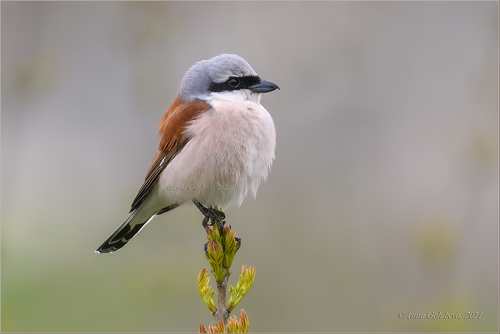
Red-backed Shrike
The Red-backed Shrike (Lanius collurio) is a captivating migratory songbird known for its distinctive predatory behavior and striking appearance. This member of the shrike family exhibits a fascinating ecological role as a small-scale predator, often impaling its prey on thorns or barbed wire, earning it the nickname "butcher bird." While not holding major cultural significance in many regions, its unique habits and declining numbers in parts of its range have made it a species of interest for birdwatchers and conservationists alike. It plays a vital role in controlling insect and small vertebrate populations within its habitat.
16-18 cm
Length
24-27 cm
Wingspan
Least Concern
Conservation Status
Distribution
The Red-backed Shrike breeds across much of Europe and western Asia, extending as far east as central Siberia. It is a long-distance migrant, wintering primarily in sub-Saharan Africa, particularly in eastern and southern Africa. Its altitudinal range varies, occurring from lowlands up to mountain slopes.
Lifespan
Typically 2-3 years in the wild, although some individuals may live longer.
Red-backed Shrike's Habitat
Habitat Types
Open woodlands, Heathland, Scrubland, Farmland with hedgerows, Savannas
Climate Zones
Temperate, Boreal, Tropical (wintering grounds)
Adaptations
Red-backed Shrikes prefer habitats with scattered trees, bushes, and thorny vegetation, which provide perches for hunting and sites for impaling prey. They are well-adapted to open areas with good visibility for spotting prey from a distance.
Variations
Several subspecies have been proposed, but there is ongoing debate about their validity. Some variations in plumage and size have been noted across the species' range, but these differences are often subtle.
Appearance
Breeding Plumage
Males have a distinctive chestnut-red back, a black mask through the eye, and a grey crown and rump. Females are duller, with brown upperparts, a less distinct mask, and barring on the underparts. Juveniles resemble females but have more extensive barring.
Seasonal Feather Changes
Plumage is generally brighter during the breeding season. After molting, colors may appear slightly duller.
Sex Based Plumage Differences
Pronounced. Males are much more brightly colored than females.
Notable Features
Strong, hooked bill, Black mask through the eye (in males), Red-brown back (in males), Sharp claws
Diet and Feeding
Primary Foods
Large insects (beetles, grasshoppers, crickets), Small vertebrates (lizards, frogs, small birds, rodents)
Foraging Behavior
Red-backed Shrikes typically hunt from perches, scanning the ground for prey. They will also hover occasionally. Once prey is spotted, they swoop down to capture it. They are known for impaling their prey on thorns, barbed wire, or other sharp objects, creating a "larder" to store food for later consumption.
Specializations
The strong, hooked bill is adapted for tearing apart prey. The behavior of impaling prey allows them to consume larger items over time and may also serve as a way to store food during periods of scarcity.
Seasonal Diet Variations
The diet may shift slightly depending on prey availability. During the breeding season, they may take more small vertebrates to feed their young. In winter, the diet may be more heavily focused on insects.
Behavior
Social Structure
Generally solitary or in pairs during the breeding season. May form small, loose flocks during migration and on wintering grounds.
Communication
Harsh, chattering calls, A variety of whistles and trills, Visual displays (e.g., wing flicking, tail bobbing)
Migration
Red-backed Shrikes are long-distance migrants, traveling between their breeding grounds in Europe and Asia and their wintering grounds in sub-Saharan Africa. They migrate primarily at night. The migration is triggered by changes in day length and food availability.
Territorial or Group Behaviors
Males are highly territorial during the breeding season, defending their territories against other males. They use calls and visual displays to advertise their territory boundaries.
Conservation
Threats
Habitat loss and degradation (due to agricultural intensification, deforestation, and urbanization), Pesticide use (reducing prey availability and potentially causing direct poisoning), Climate change (potentially affecting migration timing and prey availability)
Protection Programs
Agri-environment schemes (promoting wildlife-friendly farming practices), Habitat restoration projects, Monitoring programs
Local National Laws
Protected under various national and international laws, including the EU Birds Directive.
Population Trend
Decreasing in many parts of its range, particularly in Western Europe, although the global population is still considered to be relatively large.
Population Estimates
The global population is estimated to be between 9,600,000 and 20,100,000 mature individuals.
Interesting Facts
They are nicknamed "butcher birds"
Due to their habit of impaling prey on thorns or barbed wire.
Males sometimes decorate their larders
With brightly colored objects, possibly to attract females.
They can mimic the calls of other birds
Although the purpose of this mimicry is not fully understood.
They have very good eyesight.
They are able to spot small prey from a distance.
Faqs about Red-backed Shrike
Why do Red-backed Shrikes impale their prey?
This behavior, known as 'caching,' allows them to store food for later consumption, overcome the defenses of toxic prey (allowing toxins to degrade), and handle larger prey more easily.
Are Red-backed Shrikes endangered?
The Red-backed Shrike is currently classified as Least Concern by the IUCN. However, populations have declined significantly in some regions, particularly in Western Europe, due to habitat loss and other factors.
Where can I see a Red-backed Shrike?
During the breeding season (spring and summer), look for them in open habitats with scattered trees and bushes in Europe and western Asia. During the winter, they can be found in similar habitats in sub-Saharan Africa.
What do I do if I find an injured Red-Backed Shrike?
It is best to contact a local wildlife rehabilitation center or veterinarian. Do not attempt to handle or care for the bird yourself without expert guidance. *Consult a professional for medical or expert advice.*
Copyright @ Nature Style Limited. All Rights Reserved.
 English
English